Zero-code platforms: What is it and Why your business needs it
Sheryl is a project manager in an event management company. When one of her team members, Shanaya, had to suddenly go on leave just 3 days before a product launch event for a client, Sheryl had no time to find a temporary replacement. She literally stepped into Shanaya’s shoes and started working on her desktop to ensure there were no further delays. She was surprised to see a new social media management app Shanaya was using for the event.
With the help of other team members, Sheryl managed to complete the project in time but that social media management app she had seen on Shanaya’s desktop continued to bother her. She discussed this with the IT manager Vinita. On hearing that someone was using a new app on her desktop, Vinita got in a frenzy. She told Sheryl that using an app not approved by the IT department could result in serious security issues.
Vinita started a companywide survey of desktops and laptops to identify the apps loaded on them without the IT department’s consent. Thankfully mobile devices were not allowed to connect to the company network. She was shocked to find more than 25 different unauthorized apps being used by the employees. These apps in themselves were from reputed sources but still, they had not been vetted by the IT department and hence potentially insecure, till proved otherwise.
What are zero code platforms?
Zero code platforms use a visual development environment to create apps. Instead of writing lines of code by hand, developers use visual blocks to assemble the app. Suppose you want to add an “Insights” button to your app, which will take the user to the “Knowledge Centre” of your company website. You just need to drag the relevant icon available in the zero code platform you are using and enter the webpage address you want to direct it to. The rest of the coding and integrations will be taken care of automatically.
This ease of app development enables even those with no knowledge of programming languages – citizen developers – to develop fully functional apps. Some of the apps that are usually developed using zero code platforms include workflow management, customer relationship management, data analysis, etc.
Why do we need a zero-code platform?
Due to increasing digitization and availability of cloud storage, line of business departments expect immediate applications that solve their problems. As discussed just now, downloading the app directly from the App stores is not an option because that could be insecure. But applications that must be developed by the IT department need to go through an established process which is obviously time-consuming and need resource allocation. This means that many requirements are shot down even before they begin.
Zero code application platform can bridge the gap between these two extreme scenarios. These platforms can be used by business analysts and leaders to develop applications fully customized to departmental requirements. As the development times are very less, a prototype can be quickly developed to be showcased and approved by the stakeholders.
Top zero code platforms
Having discussed the pros and cons of zero code platforms, let’s look at some of the top zero code platforms to use in 2020, in no particular order. Some of these platforms offer a free trial while others can be used only after subscribing.
AppyPie
It has no code solutions to build mobile applications, chatbots, data integration apps, websites, and workflow automation. Using the AppyPie platform, organizations can integrate all the lines of business as well as legacy applications for optimizing performance and cutting costs. Sharing an application developed by one department is easy to share with other departments.
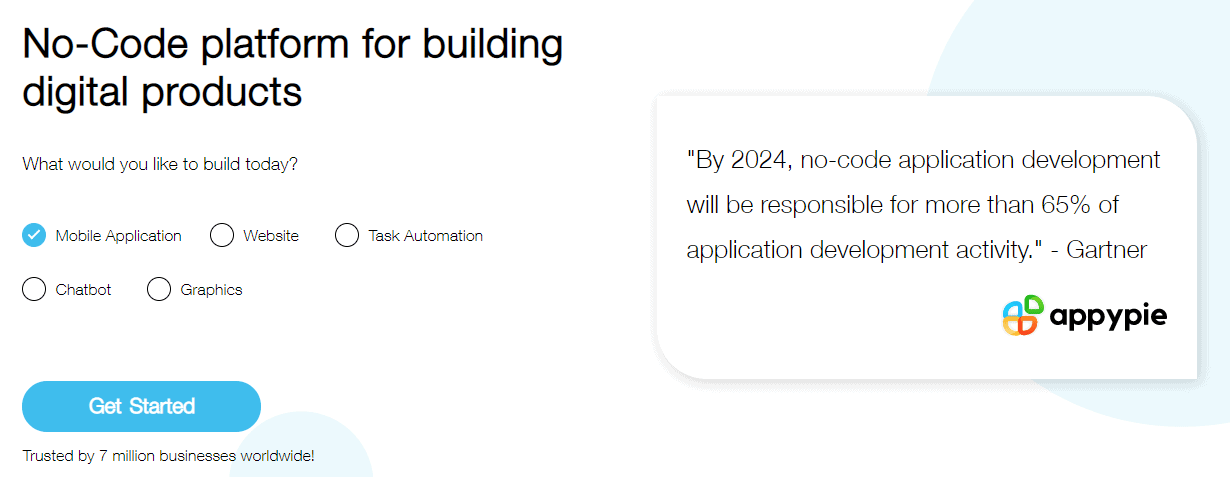
Airtable
Airtable is a collaborative tool that has the power of a database organized in the form of spreadsheets. This makes it easier to use without compromising on features. It is completely flexible and can be plugged into your website or other apps easily.

Nintex
Nintex is a platform to develop end to end process and workflow management. You can visually see your business processes and workflows, making it possible to manage and automate them. Optimizing the processes becomes pretty straightforward once the insights generated by automated processes are available.

Appsheet
It was acquired by Google to add no-code development capabilities to Google Cloud. Appsheet is primarily a mobile application building platform for data applications. Data from Google Drive, Office 365, Dropbox, and other cloud-based platforms can be integrated to create a mobile, tablet, and web applications quickly.

QuickBase
It enables an organization to transform each of its employees into a citizen developer as it can be accessed on any browser or mobile device. It seamlessly unifies data, systems, and processes to enable citizen developers to create applications that drive productivity and creativity simultaneously. Quickbase also integrates with other platforms like Salesforce, Gmail, and Box seamlessly.
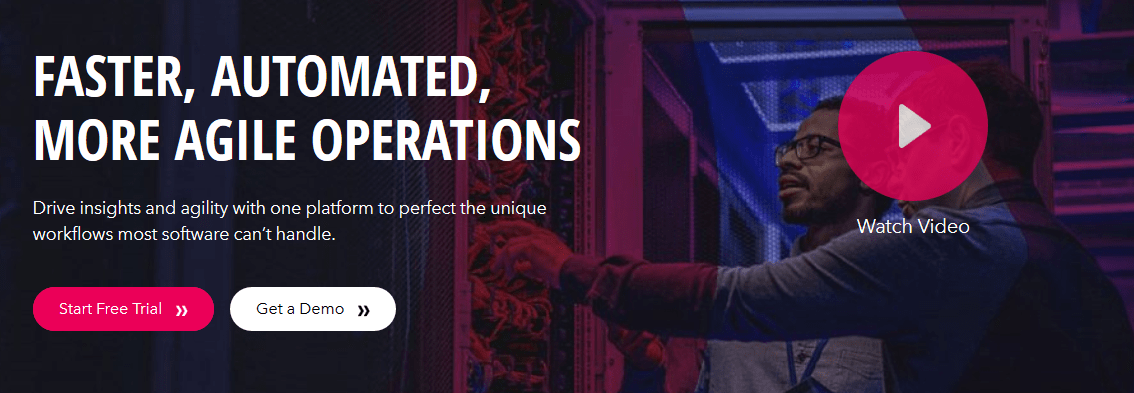
Microsoft Power Apps
Data of any enterprise can be spread over multiple locations like cloud servers, on-premise servers, online assets, etc. Microsoft PowerApps is a rapid application development platform that helps in unifying this spread out data and developing customized applications over it. A unique feature of Microsoft PowerApps is its AI build, using which you can add capabilities to your applications. Training the AI models is also simple and the processes can be automated.
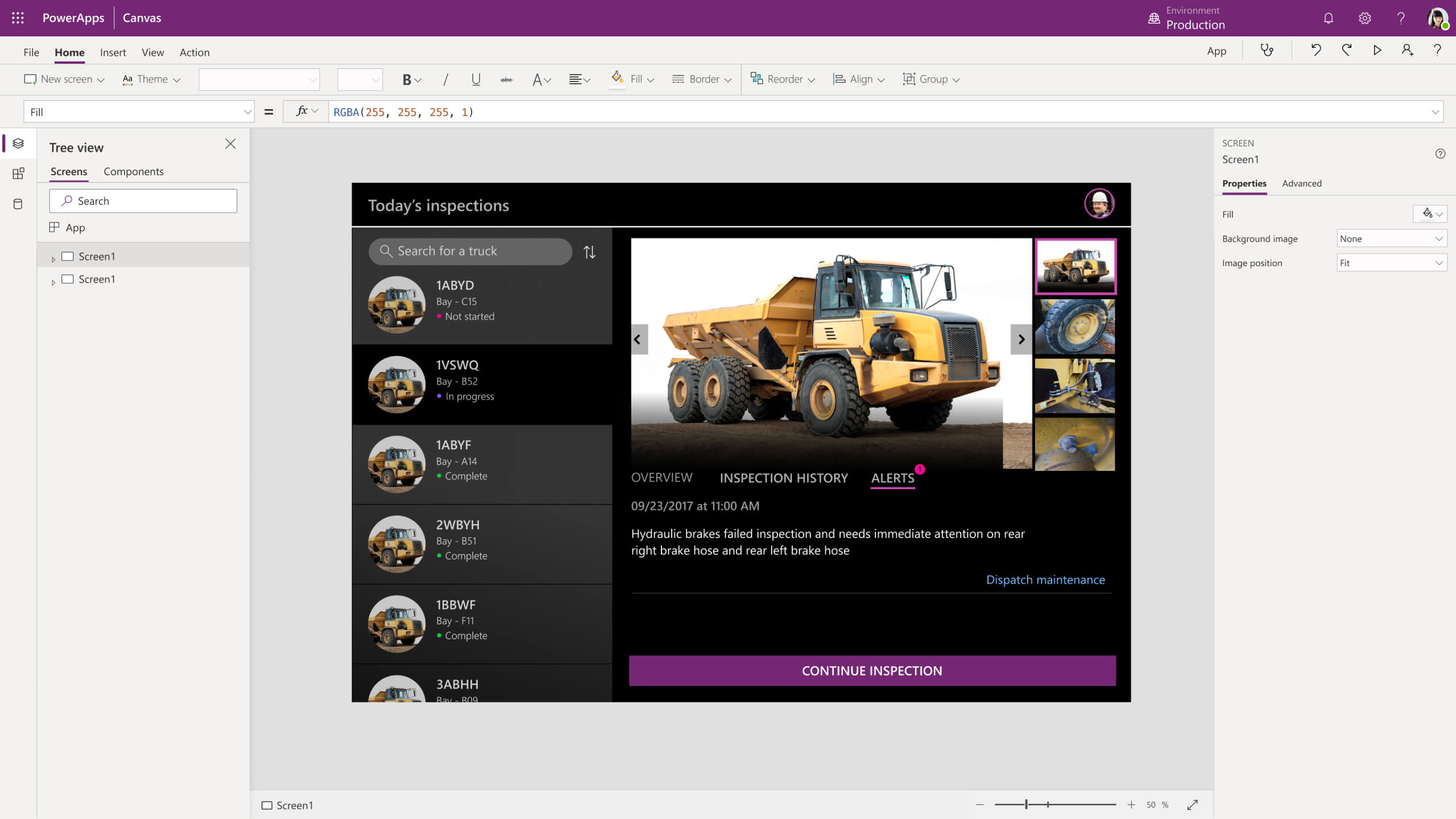
Salesforce
It is a platform-as-a-service solution for businesses of all sizes. It allows organizations to build and deploy cloud applications for automating business processes, integrating with external applications, and building line of business applications. Salesforce has made it easier to integrate sales and marketing data with enterprise data for faster product development.

Visual LANSA
Visual LANSA has a powerful development environment to create mobile, web, and desktop applications quickly and at a lower cost as compared to traditional development. It is also sometimes used by programmers because of the high level of control available.

Zoho Creator
It provides a rich library of custom forms, pages, and design work shows to build applications for mobiles, tablets for the web. Multiple developers can work on the same app simultaneously and also create duplicates for testing different features. This makes testing faster, without interrupting the current users. Zoho creator also offers native Salesforce and quick book integrations.
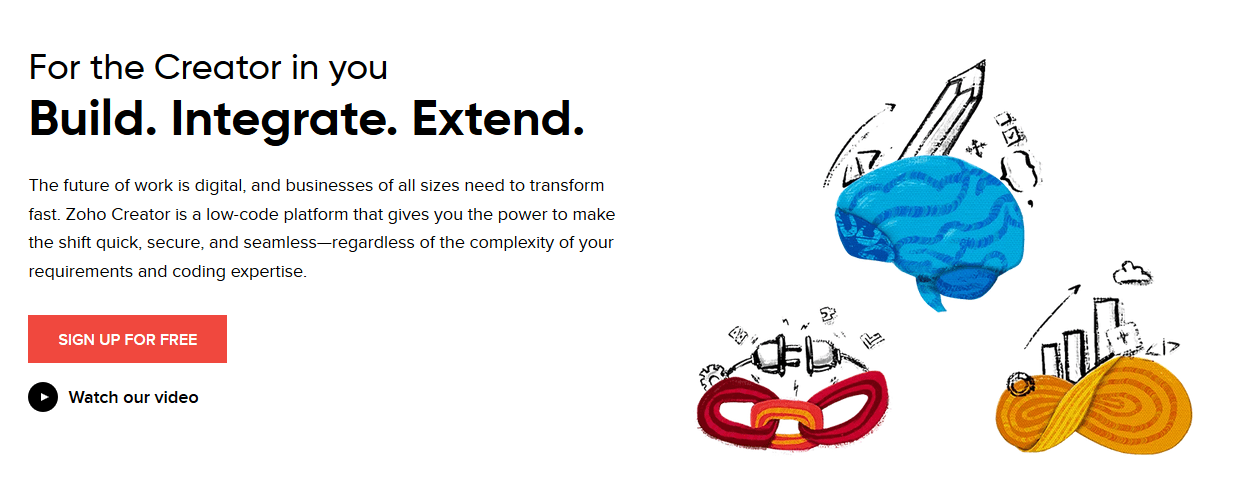
Appian
Appian is a zero-code platform ideal for organizations with minimal IT skills. It has a built-in team collaboration common Task Management and Enterprise-wide intranet capability is a. Its drag and drop process modeler enables developers to implement even the most complex logic for fast development. The apps are easy to use and fast to deploy.
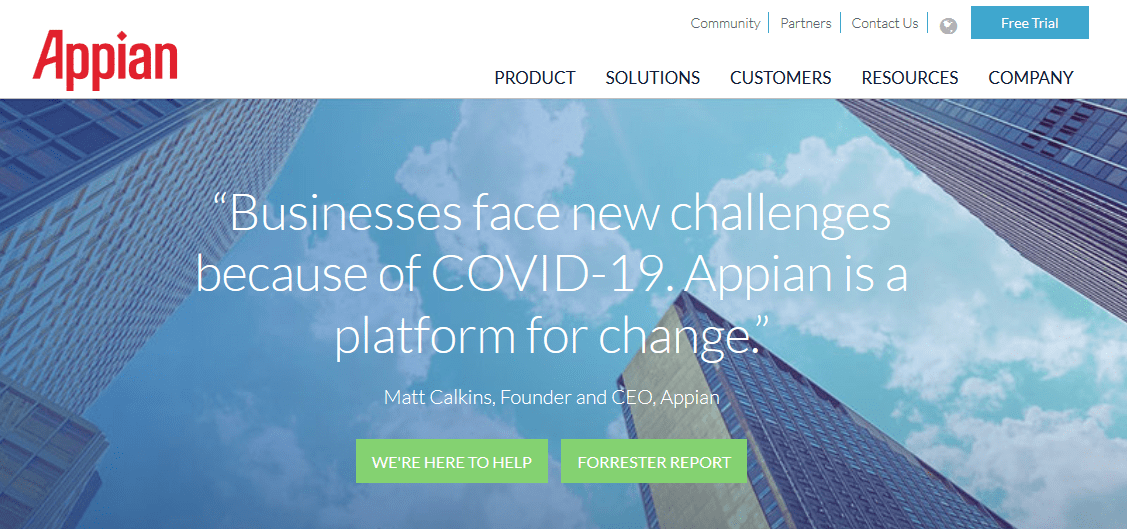
Benefits of zero code platforms
The traditional argument in favor of outsourcing software development has been that it should be done by experts aka the programmers. To develop any software application, programming experts sit with business experts to understand what the application needs to do. As we saw just now, with zero code platforms the business experts can develop solutions on their own without writing a single line of code.
These are some of the benefits that accrue as a result of this:
Decreased development times: Zero code platforms allow app development in hours or days rather than months and years that traditional software development styles could take. It is a proven fact that maximum time is consumed in understanding the business logic and how to achieve the desired outcome. When business leaders are developing the app themselves, this step can be skipped, decreasing the overall development time drastically.
Reduced cost: As time and resources required are less, it results in major cost savings. Most of the zero core platforms are completely hosted on the cloud and have a pay-as-you-use model, which is cost-effective.
Aligning IT with business: Zero code platforms enable non-developers to develop applications, reducing the burden of IT departments. It also helps in aligning IT with business requirements.
Template library: There are many templates for typical workflows in an organization that can create fully functional applications quickly.
Quick prototyping: Developers can use zero code platforms to develop prototypes quickly to test product feasibility and functionality.
Boost employee involvement: Employees are empowered to create their own solutions quickly. Instead of suggesting improvements in processes and workflows, they can show, through an app, what they wish to change. This boosts their creativity, innovation, and sense of involvement in business growth.
Characteristics of zero code platforms
The value proposition of a zero-code platform cannot be argued, especially when it comes to simple apps that can make a line of business activities faster and simpler. Let us look at the most important characteristics of zero code platforms:
WYSIWYG editor: The learning curve of any WYSIWYG interface is flat, which makes it super simple for non-developers to understand how the platform works. They can start developing apps right away, saving time.
Graphical user interface: Drag and drop elements make it easy to assemble applications quickly. Sometimes even developers use this platform so that they can roll out applications quickly.
Templates library: Large number of templates make it easy to develop an application for typical workflows like project tracking, file sharing, chatting, etc.
Fully customizable: These platforms usually have a huge library of elements that make it simple to customize applications according to an organization’s business needs and policies.
Unified application interface: Standard interface can be maintained for all the applications because the platform used is the same.
Challenges of zero code platforms
Forrester predicts that the zero code development platform market will be worth USD 21.2 billion by 2022, up from USD 3.8 billion in 2017. Despite this massive growth and global adoption across industries, zero code platforms have their own challenges:
- Users must be very clear about their requirement. As there are no specialists in analyzing the requirement, the person developing the app must do everything themselves.
- It is not possible to do anything outside the available templates.
- The developers do not own the source code. The implementation of their logic is a black box that cannot be accessed.
- There is a real issue of vendor lock-in if the organization decides to change platforms.
- Businesses must ensure that the apps are running from secure clouds and have the necessary industry certifications for data security, like ISO 27001.
How TechAhead can help
Zero code development platform is a visual way of developing applications, which can be used even by non-programmers. The idea here is that technology, or lack thereof, should not hold an organization back. A visual drag and drop app development environment can equip your business to develop and distribute customer-facing apps quickly.
Team of software developers at TechAhead are experts in creating no-code platforms that can be used by employees to develop applications and to their own specifications. Here are some activities that we undertake for developing a fully customized no-code platform for your business:
- Experts confer with all the stakeholders, typically vertical or departmental heads, to understand their pain points.
- A list of processes that need to be automated is drawn up.
- A list of typical applications that are usually needed by employees is created.
- Experts draw on their past experience to add applications that could be needed in the future.
- A blueprint of the no-code platform, outlining its capabilities is shared.
Getting your own zero-code platform developed ensures you can build customizations, integrations, and security measures into it. The made-to-order zero-code platform can also be made governable by your IT department.
The landscape of software development has been changing to rapid application development. Zero code development is the future of and businesses need to adopt it quickly if they wish to stay ahead of the game.
Summary
Application development platforms with drag and drop graphical user interface that allows even the non-programmers to develop applications without writing a single line of code is called the zero-code platform. It helps rapid development of the line of business applications that drive productivity while reducing the cost of its development. The library of templates allows quick development of applications with a uniform interface, driving enterprise-wide innovations.
As the business leaders and analysts developing the apps themselves, there is no gap between requirement and the product developed. However, this also means that they must be very clear about what they wish to achieve out of the app. Applications developed using zero code platforms do not make the source code available to its developers. So, if an organization wants to develop a more secure and robust AP over it is not possible. If the organization decides to change platforms, the vendor can very much refuse the continued use of the app.
The solution to this can be a zero-code platform that is built specifically for an organization and governable by its IT department. This also enables IT teams, to add customizations and integrations to apps developed by the citizen developers
Source: techaheadcorp






